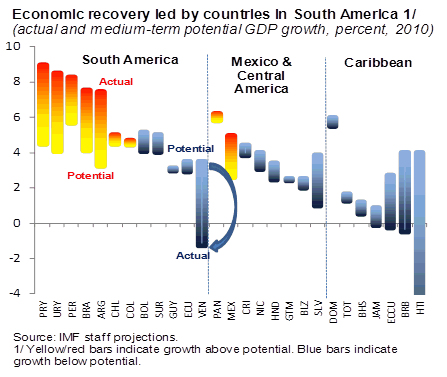
Typical street scene in Santa Ana, El Salvador. (Photo: iStock)
IMF Survey: Strong Recovery in Latin America, But Eye on Overheating
October 19, 2010
- Latin America's growth stronger than anticipated
- Need to proceed with timely removal of stimulative policies
- Regulatory policies can complement traditional macroeconomic policy tools
With many Latin American and Caribbean economies recovering faster than anticipated, the challenge for policymakers is ensuring a moderation in domestic demand to avoid overheating, the IMF said.

Car shopping in São Paulo: Brazil is one of the fastest growing countries in South America (photo: Paulo Fridman/Corbis)
Regional Economic Outlook
In its new Regional Economic Outlook for the region, issued on October 19 in Bogotá, Colombia, the IMF said that, after posting impressive gains in the first half of 2010, growth in the region is projected to moderate somewhat during the remainder of this year, but remain above trend. This strength shows up especially in South America, where a number of economies are growing at rates of 7 percent.
In Central America, the recovery is also progressing, but more gradually, while in the Caribbean, growth remains muted, following a severe contraction last year, the report said.
“Overall our region is performing very well, with growth close to 6 percent this year,” Nicolás Eyzaguirre, Director of the IMF’s Western Hemisphere Department, said. “This growth has been led by fast domestic demand, pushed to a big extent by very good external conditions—especially higher export prices and very loose global financial conditions.”

Easy conditions, stimulative policies
But the timing and path of the recovery will vary among the region’s economies, depending on external influences and the legacy of their past policies and their policy frameworks, the IMF said.
The current global setting is stimulative for those economies with greater real linkages to the more dynamic emerging economies, and for those likely to be most attractive to foreign investors. Many of the commodity-exporting countries of South America are facing highly favorable conditions—particularly those with stronger fundamentals, who have easiest access to credit. The report predicted that dynamism of China and other Asian economies will keep the price of South America’s key commodity exports high.
On the other hand, the environment is least favorable for those with strong real linkages to the weaker-performing advanced economies. This is the situation for many countries in Central America, with close ties to the U.S. economy, in terms of income from exports and workers’ remittances, and much more so for the tourism-dependent economies of the Caribbean.
Global environment shapes policy challenges
For many countries of South America—where growth recently has been even stronger than expected—policy challenges center on avoiding overstimulation of demand and credit, which would turn unsustainable. Although the strong recovery of domestic demand has been welcome in terms of bringing economies back to potential, its continued rapid expansion could bring overheating, inflation, and widening current account deficits, the IMF warned.
For these economies, it is essential to proceed with the timely removal of policy stimulus while ensuring that the monetary/policy mix does not attract stronger capital inflows. Allowing exchange rate flexibility can also help—too little flexibility can attract more capital inflows and facilitate a credit boom.
In Central America, where output gaps are modest, the usefulness of applying further fiscal stimulus would be limited. Countries should therefore rebuild the policy space to guard against future shocks. Structural changes, rather than demand policies, will be key to boosting growth and competitiveness.
For many countries in the Caribbean, where the recovery has begun only recently, the very high public debt levels allow no space for fiscal stimulus. With such high debt acting as a drag on growth, these countries will do best to pursue steady fiscal consolidation, while focusing expenditure on protecting the poorest households. The report also noted the substantial room for productivity gains, and for further development of the tourism sector to boost growth.
Strengthening financial stability
Latin America made significant progress in strengthening its financial sector over the past decade. The resilience of the region’s financial systems to the recent global crisis is testimony to that progress, but the job is never done. The broad challenge for the region is to increase financial depth safely, without exacerbating economic cycles, according to the IMF.
To achieve this goal, economic stability needs to be preserved, prudential regulations enforced, and financial supervision further strengthened. Legal, regulatory, and judicial changes that improve creditor rights can increase the security of domestic deposits and bonds. Ultimately, these policies will expand credit opportunities in the economy.
If properly managed and supervised, domestic securities and derivative markets can also deepen domestic financial intermediation and strengthen financial stability by allowing financial institutions and firms to better manage risk.
Complementary measures
Regulatory policies to complement—but not substitute for—traditional economic policy tools, are also important, particularly in the current context of easy external financing conditions, the IMF said. Despite the emerging agreement on the need to adopt a “macroprudential” financial policy perspective, its design and practical implementation will not be a simple matter.
The IMF report therefore discusses a number of general considerations to help guide the use and integration of new macroprudential policies into existing policy frameworks in Latin America:
• Interaction with traditional macroeconomic policy tools. While the use of prudential instruments for macroprudential purposes could effectively add to the economic policy toolkit, such policies should not substitute for an appropriate degree of exchange rate flexibility, the first and critical line of defense to guard against strong capital inflows. Having a good balance of monetary and fiscal policies is also essential.
• Broad-range oversight. Macroprudential oversight should encompass the entire spectrum of financial activities.
• Targeting intervention as needed. Prudential measures should aim to “lean against the wind” in the specific sectors concerned at a particular juncture.
• Embedding macroprudential policies in an institutional setup. The adopted institutional mechanisms should have clear mandates, transparency, and principles for coordination and accountability.







